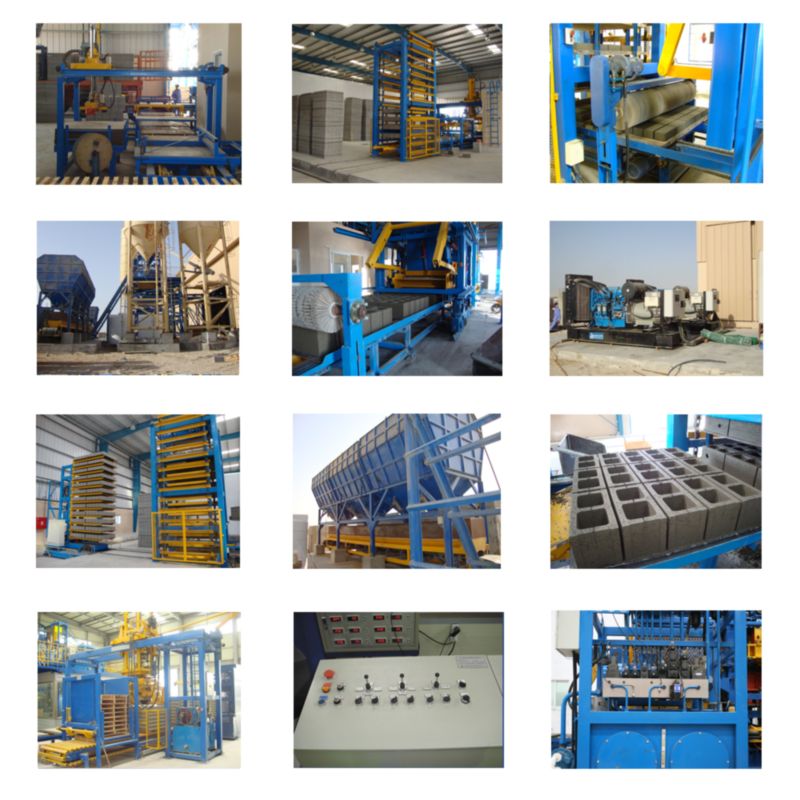REIT automatic frequency concrete block machine is a production line developed by Beijing ruitu Technology Development Co., Ltd. according to the needs of users and domestic market. In terms of type selection and configuration, the line takes into account the needs of many domestic users, as well as its technical level, equipment performance and reliability. It should be at the leading level in China. Its key components are the products of many well-known enterprises at home and abroad, and its performance and technical indicators have certain advantages over foreign equivalent equipment.
REIT Automatic Frequency Concrete Block Machine.From the perspective of structural composition and production process flow, the whole line can be divided into six parts, namely batching and mixing system, forming system, product conveying system, stacking system, pallet return system and control system.
1. Batching and mixing system:
The system includes silo, cement silo, metering device, elevator, mixer and belt conveyor.
The computer-controlled automatic batching system will mix various types of aggregate and cement according to the preset proportion and send them to the mixer; While mixing, the mixer controls to add a certain amount of water through the imported humidity controller. After the mixed materials meet the requirements, they will be automatically placed on the feeding belt conveyor and sent to the hopper of the forming host through the feeding conveyor belt conveyor. The system can use a wide range of raw materials. Including rubble, stone slag, brick and tile slag, gravel, perlite, slag, fly ash and furnace bottom ash; The gelling agent is 8-16% p.o42 Ordinary portland cement No. 5.
2. concrete block maker machine Molding system:
The system includes pallet bin, automatic plate feeder, forming host, etc.
The empty pallet is sent to the forming host from the pallet bin behind the forming host through the automatic plate feeder. The prepared concrete materials are quantitatively discharged into the distribution box by the hopper in batches, and then the mixture is pushed to the mold surface and evenly filled into the mold cavity through the rapid distributor. During this period, necessary distribution vibration shall be carried out to obtain the specified distribution compactness. After the distribution is completed, the die indenter goes down to compact the material to a certain extent. At the same time, the vibrator starts to vibrate. After several seconds of strong vibration, the raw material is formed into a wet product with designed shape and compactness in the die cavity. After the vibration is excited, the mold and pressure head are lifted by hydraulic oil cylinder to make the product demould smoothly. Remove the wet product while supplying the board to the molding host next time.
3. Product conveying system:
The system has wet product conveying and dry product conveying. It mainly includes wet product conveyor, wet product cleaning device, mobile stacker, twin mother kiln car, mobile stacker and plate lowering pitch machine.
After the wet products and pallets are removed from the main machine, they are sent to the mobile stacker by the wet product conveyor, and the surface defects of the products are cleaned by the wet product cleaning device before entering the machine. A group of wet products (8 layers and 16 plates) in the mobile stacker are taken out by the program-controlled kiln car, and transported to the reserved position of the curing kiln according to the requirements of the curing system, and the group of wet products are unloaded for curing. At the same time, another program-controlled kiln car will take out a group of dry products that have been cured at its location and send them to the mobile destacker. Then move the destacker to unload the plates one by one according to the control requirements, put them on the pitch machine, remove them through the pitch machine and send them to the stacking system.
4. Palletizing system:
The system includes automatic low-level stacker, plate separator, block arranging machine and rotary table.
When the pallet with dry products is sent to the stacking position, the plate separator pushes the dry products out of the pallet, moves a certain distance and places them on the block arranging machine and low-level stacking machine. The low-level stacker shall stack to the specified number of layers by matching the layers with the rotary table and staggering 90 degrees. A group of finished products stacked shall be transported to the outdoor finished product stacking yard by manually driven forklift; At the same time, place the empty tray on the rotary table.
5. Pallet return system:
The system includes pallet pitch machine, pallet cleaning device, turnover machine and pallet transfer device.
The unloaded empty pallet enters the pallet return system along the descending pitch machine. Firstly, the surface of the pallet shall be cleaned by the pallet cleaning device, and then it shall be turned over 1800 by the turnover machine, so as to avoid warping and deformation of the pallet under long-term single-sided load. After that, the pallet is sent to the pallet bin of the forming system through the pallet transfer device.
6. concrete block maker machine Control system:
The connection and coordination of all links in the above process flow are automatically controlled by the central computer console with the programmable logic controller of Siemens as the core according to the pre programmed program and process parameters. Stable performance, safe and reliable.
FAQ:
What machine is used to make blocks
Concrete block making machine is a machine specially used to manufacture various concrete blocks. It can be used to make blocks of various specifications and sizes by changing different molds. For example, concrete hollow blocks, paver blocks, solid blocks, interlocking bricks, curbstones.






